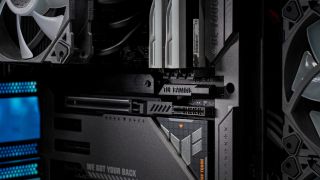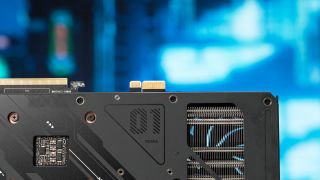
Asus is working on a concept design for GeForce RTX 40-series (Ada Lovelace) graphics cards that don’t require any power connectors for external power. Instead, the vendor has designed a proprietary slot that delivers up to 600W of power on a custom Z790 motherboard with back-facing connections. We saw the demo at an Asus briefing this week
The 16-pin power connector (12VHPWR) made many headlines last year because the power adapter melted on a few GeForce RTX 4090 graphics cards. Unfortunately, the issue is ongoing, as new cases of the 16-pin meltdowns surfaced a week ago. Nvidia attributed the problem to user error because the 16-pin power connector wasn’t correctly installed in some scenarios.
Asus’ design doesn’t completely remove the user factor from the equation. Still, it does help minimize the possibility of occurrence since the 16-pin power connector isn’t on the graphics card anymore but on the motherboard, where there is more liberty to maneuver the power cable.

The GeForce RTX 4070 Megalodon is the first prototype to feature a connector-less design. However, the branding isn’t final yet so the retail product may have another name. At first glance, the GeForce RTX 4070 Megalodon looks like a regular 2.3-slot graphics card.



However, upon closer inspection, you’ll notice that there aren’t any PCIe power connectors. In their place, Asus implemented a proprietary connector that resembles a PCIe x1 connector. However, it has the same power delivery as the 16-pin power connector, up to 600W. Asus has baptized the connector as “GC_HPWR” for now, but the company said it’d have an official name at launch.

Asus isn't the first vendor to slap a custom connector on the graphics card to provide power. For example, AMD has produced some Radeon Pro graphics cards for Apple that use the latter’s MPX (Mac Pro eXpansion) form factor. However, Asus’ custom power connector, which doesn’t have an official name yet, isn’t as long as Apple’s implementation.
Asus demonstrated the GeForce RTX 4070 Megalodon alongside a TUF Gaming Z790 BTF, a motherboard with connectors on the back. It's a design based on the DIY-APE standard. The GC_HPWR connector on the motherboard essentially acts as a pass-through for the 16-pin power connector because the power has to come from somewhere.
Stay on the Cutting Edge
Join the experts who read Tom's Hardware for the inside track on enthusiast PC tech news — and have for over 25 years. We'll send breaking news and in-depth reviews of CPUs, GPUs, AI, maker hardware and more straight to your inbox.


However, Asus also went the extra mile and added three 8-pin PCIe power connectors to the mix. Therefore, consumers may choose the three-cable solution or the single 16-pin alternative. Even though the motherboard has the special GC_HPWR connector, it doesn't limit its usage. Consumers can use regular graphics cards on Asus' motherboard.
Asus' BTF motherboards were previously restricted to the Chinese market. However, the company said that the TUF Gaming Z790 BTF and the GeForce RTX 4070 Megalodon would hit the global markets. Pricing is unknown, but Asus confirmed that they would carry a slight premium since there's the added cost of moving the connectors to the back of the motherboard. Not to mention that consumers will also have to shell out more money for a case designed for Asus' BTF motherboards.
In the meantime, the GeForce RTX 4070 Megalodon is kept inside Asus' ecosystem. Unfortunately, the brand didn't state whether it'll open the proprietary design to other motherboard vendors. But more importantly, will other manufacturers be willing to jump on the new design since it'll involve additional cost and human resources to redesign existing motherboards and graphics cards to meet the standard? Then there's the existent risk that the design doesn't take off.

Zhiye Liu is a Freelance News Writer at Tom’s Hardware US. Although he loves everything that’s hardware, he has a soft spot for CPUs, GPUs, and RAM.
-
Metal Messiah. On the other hand, MSI is taking a more practical/novel approach by introducing "coloured" 12VHPWR cables. :) This idea and concept sounds pretty good though.Reply
They are supplying coloured 12VHPWR connectors that use bright yellow plastic terminals. This coloured plastic is only visible when the cable is not fully connected to the 12VHPWR connector on your power supply or graphics card, so we can easily spot if the cables are incorrectly seated.
NOT connected properly. Yellow color is visible here.
https://i.imgur.com/9qRmsfV.jpg
Fully connected properly:
https://i.imgur.com/lYUd8hp.jpg
d1WLq4arovo:2View: https://www.youtube.com/watch?v=d1WLq4arovo&t=2s -
Roland Of Gilead That looks very cool, and minimalist in terms of garish cabling.Reply
I also liked the PSU rotated by 90 degrees article. I think innovation is good, but not just for the sake of it. I hope more manufacturers think a little outside the box, instead of the same old, same old!! -
Roland Of Gilead That's a nice touch. I don't know though, if it's as clean looking as the Asus look.Reply
Here's a pic of my own innards, and I would love to get that cable out of there.
zx5sZr3View: https://imgur.com/zx5sZr3. Taking that power cable out, and somehow making the AIO pipes sit hidden (I can still dream :). Still cleaner look IMO. -
Nazosan I'm a bit concerned that this is potentially a really bad idea for the simple reason that this means all that power is running through the motherboard. Even assuming dedicated pathways it adds more complexity and more points for something to go wrong. Many GPUs can easily hit power draws as high as 20 amps or more and that's why they normally would have a direct power connection to the PSU itself. After all, the motherboard already provides a pretty fair bit of power to the PCI-E slots -- enough to power lower end videocards directly -- but sets a limit for a good reason. Even with dedicated separate pathways, we're talking many amps going through, and ultimately crossing paths (I'm assuming a multi-layered board of course.) The only way I can see this not being potentially a pretty big problem is if the board has a separate plug dedicated just to GPU power that connects as closely to the card's location as possible. Which... kind of defeats the entire purpose anyway.Reply -
slurmsmckenzie Reply
I think I read that this custom motherboard has some connectors at the back so maybe that is the idea, to keep things looking neat? I'm not fussed about that personally though, as long as cables don't mess with airflow too much I don't mind what they look like as I don't have them on display!Nazosan said:The only way I can see this not being potentially a pretty big problem is if the board has a separate plug dedicated just to GPU power that connects as closely to the card's location as possible. Which... kind of defeats the entire purpose anyway. -
Amdlova Nice now will melt the cpu the motherboard and the graphics...Reply
Easy way to rma the case for asus. -
btmedic04 looks like asus is pushing the boundaries one potential house fire at a time. no thanks, never asus againReply -
Nazosan Reply
I have no doubt that this is to look neat, yes. It's also just a bit more convenient not having to run cords through to the GPU (might even help a tiny tiny bit with airflow, though usually they're pretty small except on dual power input GPUs.) Still, we're talking about potentially in excess of 50A passing through that board at times and even if it's split up pretty well that sounds like trouble brewing to me.slurmsmckenzie said:I think I read that this custom motherboard has some connectors at the back so maybe that is the idea, to keep things looking neat? I'm not fussed about that personally though, as long as cables don't mess with airflow too much I don't mind what they look like as I don't have them on display! -
tamalero Reply
As long ASUS's software doesnt f.. up and overvolts too much and fries the connector, the card and the motherboard.Metal Messiah. said:On the other hand, MSI is taking a more practical/novel approach by introducing "coloured" 12VHPWR cables. :) This idea and concept sounds pretty good though.
They are supplying coloured 12VHPWR connectors that use bright yellow plastic terminals. This coloured plastic is only visible when the cable is not fully connected to the 12VHPWR connector on your power supply or graphics card, so we can easily spot if the cables are incorrectly seated.
NOT connected properly. Yellow color is visible here.
https://i.imgur.com/9qRmsfV.jpg
Fully connected properly:
https://i.imgur.com/lYUd8hp.jpg
d1WLq4arovo:2View: https://www.youtube.com/watch?v=d1WLq4arovo&t=2s -
BillyBuerger As someone who likes to avoid cable clutter, I think this is an interesting idea. Although I'm not sold on the power connectors on the back. You could still have the GPU power on the motherboard with a direct supply to the GPU power connector. It's interesting at least.Reply
As for the concern about the power running through the motherboard, that's exactly what is happening on the GPU already. All that current is passing through the GPU PCB from the power connector to the VRMs to feed the GPU. So doing the same thing on the MB doesn't sound like a huge deal to me. Not to mention server CPUs pull some crazy high power as well and they have to do so through the MB PCB as well. This isn't unheard of and can work. Although yes, it does mean more points of failure on the MB. But the 12VHPWR connector has shown that not putting this power on the motherboard has issues as well. Having 3x 8-pin (or maybe a single 20pin ?) connectors on the motherboard for GPU power would be easier to work with than the 12VHPWR or having 3x 8-pin power connectors on the GPU.
Most Popular






